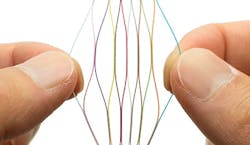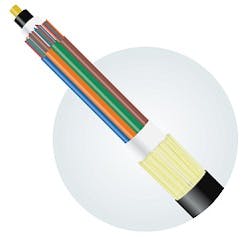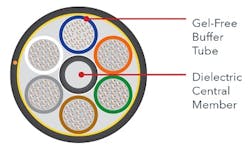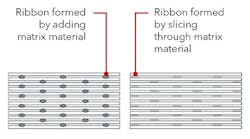We're all using more bandwidth than ever, and that trend is anticipated to continue for the foreseeable future. That means more fiber is being installed than ever before.
Although there appears to be infinite demand for bandwidth, there definitely is a limit to the space available to place optical fiber. Placing more fiber in less space can be very important to today's network operator, especially in crowded metro areas.
Rollable fiber ribbons can enable roughly twice the density versus existing outside plant cabling methods, making them a very valuable tool in the network designer's toolbox.
A history lesson
Although the United States has been the engine for many fiber-optic innovations, Japan has contributed several fundamental technologies used in today's networks. These advances include the SC connector as well as Vapor Axial Deposition (VAD) fiber manufacturing, the manufacturing method used to make much of the world's single-mode fiber.
The classic Japanese method for fiber innovation includes a problem that is proposed and addressed by multiple manufacturers. Fiber density is one such problem, and in the early 2000s, Japanese companies began working on the concept of rollable fiber ribbons. So the concept for such fibers is not new, but it has only recently begun to be used in North America.
The initial application of rollable ribbon cable products in North America has been mainly to connect data centers within a campus or metro area with high fiber count cables over short distances of up to a few kilometers. Now, interest is expanding to other applications, such as fiber to the home (FTTH) and mobile network backhaul and fronthaul.
What is a rollable ribbon?
A rollable ribbon is a fiber-optic ribbon that can be rolled into a tight cylinder, in contrast to a classic flat ribbon, which is designed to stay flat while in the cable and during splicing.
flat ribbon splicing techniques.
Where a flat ribbon is connected by matrix material between fibers down the entire length, the fibers in a rollable ribbon are only connected at regularly spaced points down the length of the fiber, which makes it more flexible and "rollable." This design enables the fibers to be spliced using ribbon splicing techniques and equipment while providing much higher density.
What's the big (or small) deal?
In dense metro environments, many ducts are crowded. Following the laws of supply and demand, crowded ducts can be more expensive. Fiber is comparatively less expensive, so service providers correctly want to increase duct efficiency (and decrease per fiber duct costs) by placing as many fibers in a duct as possible. Rollable ribbon cables double the fiber density for a typical 1.25- or 2-inch duct, enabling thousands of fibers go to into spaces that were previously too small for such numbers.
Smaller size provides many other benefits:
- Lighter weight, for longer pulling/blowing distances, decreasing installation costs
- Smaller coiling diameters, for potentially smaller handholes
- Smaller cables can enable longer lengths on a reel. Longer lengths can reduce the number of splice points and splicing costs, while the use of longer lengths and lighter cables can reduce shipping costs
Rollable ribbon cables are gel-free. Removing gel also decreases weight, but its main benefit is to accelerate and simplify the splicing process.
Taking the splicing process into account, the list of rollable ribbon benefits gets even longer:
- Rollable ribbons can be spliced using ribbon splicing techniques, maintaining the productivity and restoration speed benefits of ribbons.
- It's easier to break out individual fibers from the ribbon structure.
- There's potential to use smaller splice trays, which improves closure density, since rollable ribbons are cylinders instead of flat.
- In comparison to ribbonizing loose tube structures, it's almost impossible to cross-splice fibers in a ribbon. Cross-splicing fibers when ribbonizing a loose tube cable can be very difficult to troubleshoot.
Totaling up the benefits, rollable ribbon cables can significantly reduce overall installation costs.
Let the buyer beware
So, rollable ribbons will solve all network problems, right?
Those who have been around the telecom/outside plant/fiber industries long enough know that new technologies should be carefully evaluated. There are a few considerations that need to be mentioned:
Although the basic idea has been around for a while, rollable ribbon cables have not been delivered anywhere close to the scale of either standard flat ribbons or loose tube cables. This means that the cables are typically more expensive than comparable options. That said, the right design can offer benefits that can result in a lower installed cost than for either standard loose tube or flat ribbon cables.
Although ribbon splicing techniques are used, there are some subtle operational differences between splicing rollable ribbons and flat ribbons. This means there's a small learning curve as splicers work with it for the first time.
There are limited sources and availability of products.
Finally, cable and ribbon designs are not as standardized as more traditional designs and there are significant differences between ribbon and cable designs from manufacturer to manufacturer. Since these cables are used more with higher fiber count designs, the financial consequences of picking the wrong product can be substantial.
Details matter
The industry is in its early days of rollable ribbon deployments. Keep in mind that most of the development to this point has occurred in Japan, so it's logical that the first cable designs to be promoted are designs that are more popular in Japan. Two such designs are "wrapping tube" and "slotted core" cables.
designs brings many advantages.
A third design, "ribbon in loose tube" (RILT), is a more familiar and field-proven design in North America, with several manufacturers offering products with this structure for over 15 years. The RILT design offers several advantages over the alternative designs:
Cable pulling
- The absence of a preferential bending plane versus linear strength element designs (such as wrapping tube) can enable easier coiling, handling, and slack management
- Less concern about jacket damage after pulling versus slotted core designs
- More layers of fiber protection and easier fiber management versus wrapping tube cable designs.
Cable prep for splicing
- RILT provides easier ribbon and mid-span access than either slotted core or wrapping tube cable designs. This can be significant, especially for FTTH and mobile fronthaul/backhaul networks requiring frequent cable access and connections.
- Loose tubes provide additional protection to fibers during the preparation process; it's less likely a technician will nick or cut fibers during cable stripping versus other cable designs.
- Fibers are grouped in color-coded dry buffer tubes, making splicing and mid-span access easier versus string binder groups.
easy ribbon and mid-span access.
Splicing and testing
- How the ribbons are made is important. A shorter distance between fiber attachment locations provides flatter, more controllable ribbons during splicing. This results in a ribbon that springs back into shape better, aiding the splicing process.
- The wrapping tube design requires string binders to group ribbons together. The RILT design uses traditional color-coded buffer tubes and numbered and striped ribbons for easier identification.
- The RILT design features optical fiber with a 9.2 ± 0.4 μm (1310 nm) and 10.4 ± 0.5 μm (1550 nm) mode field diameter to provide G.657.A1 bending performance with seamless splicing to the installed base of fibers, versus other designs requiring a smaller mode field diameter that can cause "gainers" and elevated losses during OTDR testing.
Long-term performance
- There are different ways of making rollable ribbons. One way is to add matrix material to form the attachment points. Another way is to slice open existing flat ribbon. However, this second approach brings the risk of damaging fibers or fiber coatings, which could compromise long-term reliability. The process of adding material to manufacture optical fiber ribbons and cables has been proven for decades, with millions of miles of cable in reliable service.
fiber ribbons and cables is field proven for decades.
Summary
Rollable fiber cables are one of the most exciting developments in outside plant cabling technology in years. Benefits include smaller cable diameters and weights, lower transportation and installation costs, and the use of a gel-free, ribbon-spliceable package.
Although initial applications have focused primarily on data center interconnections, rollable ribbon cables are now being considered for applications requiring frequent access, such as FTTH and mobile backhaul and fronthaul.
Out of the various available cable designs, the RILT cable structure is ideal for use in applications requiring frequent access and has many additional advantages.
Is it time for your network to begin rolling in fiber?
Mark Boxer is an applications engineering manager at OFS.





